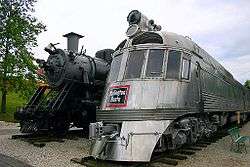Rolling stock

The term rolling stock originally referred to any vehicles that move on a railway. It has since expanded to include the wheeled vehicles used by businesses on roadways. It usually includes both powered and unpowered vehicles, for example locomotives, railroad cars, coaches, and wagons.[1][2][3][4]
Overview
Rolling stock is considered to be a liquid asset, or close to it, since the value of the vehicle can be readily estimated and then shipped to the buyer without much cost or delay.
The term contrasts with fixed stock (infrastructure), which is a collective term for the track, signals, stations, other buildings, electric wires, etc., necessary to operate a railway.

 DMU rolling stock
DMU rolling stock American-style hopper car
American-style hopper car Articulated well cars with intermodal containers
Articulated well cars with intermodal containers
Code names
In Great Britain, types of rolling stock were given code names, often of animals. For example, "Toad" was used as a code name for the Great Western Railway goods brake van,[5] while British Railways wagons used for track maintenance were named after fish, such as "Dogfish" for a ballast hopper.[6] These codes were telegraphese, somewhat analogous to the SMS language of today.
See also
References
- ↑ "Yaxham Light Railway rolling stock page".
- ↑ "Definition of "rolling stock" from the Oxford English Dictionary accessed 5 February 2007 (subscription service)".
- ↑ "Definition of "rolling stock" from the Concise Oxford Dictionary".
- ↑ "Definition from the American Heritage Dictionary".
- ↑ "Code Names for Great Western Carriage Stock and Vans". greatwestern.org.uk.
- ↑ "Fishkinds and TOPS". btinternet.com. Archived from the original on 11 October 2012.
External links
| Wikimedia Commons has media related to Rolling stock. |
 The dictionary definition of rolling stock at Wiktionary
The dictionary definition of rolling stock at Wiktionary